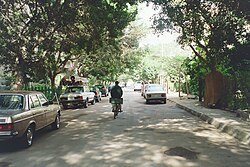Maadi, Egypt
|
Maadi المعادى |
|
|---|---|
| District | |
| Arabic transcription(s) | |
| • Common | el-Ma‛adi |
 |
|
 Map of Maadi (inset: map of Egypt) |
|
| Location of Maadi in Egypt | |
| Coordinates: 29°58′N 31°15′E / 29.967°N 31.250°ECoordinates: 29°58′N 31°15′E / 29.967°N 31.250°E | |
| Country | Egypt |
| Governorate | Cairo |
| Time zone | Egypt Standard Time (UTC+2) |
Maadi or al-Ma'adi (Arabic: المعادى / transliterated: al-Ma‛adi pronounced [elmæˈʕæːdi]) is an affluent, leafy suburban district south of Cairo, Egypt on the east bank of the Nile about 12 km upriver from downtown Cairo. The Nile at Maadi is parallelled by the Corniche, a waterfront promenade and the main road north into Cairo. There is no bridge across the Nile at Maadi; the nearest one is located at El Mounib along the Ring Road (Tariq al-Da'iri) on the way north to the downtown.
Maadi population can raise up to 5.6 million in 2016, the district is popular with many international expatriates as well as Egyptians and is home to a large number of embassies, as well as major international schools, sporting clubs, and cultural institutions such as the Supreme Constitutional Court of Egypt and the national Egyptian Geological Museum. (See below for details on embassies, schools, clubs, etc.)
Ma'ǎdi معادي is the plural form of the Arabic word ma'diyya معدية, which means "ferry"; hence, al-Ma'adi literally means "the ferries". There was a story that the name comes from a ferry crossing in the area where ferries carried people from the east side of the Nile to the west.
Today's Maadi stands on the site of a town that has turned out to be a significant predynastic, Ancient Egyptian archaeological site, founded ca. 3500 B.C. Building activity in the area has destroyed some archaeologically sensitive places.
Maadi traces its modern history to 1904, when the railway between Cairo to the north and Helwan to the south was built. This, in combination with land speculation by the Mosseri cousins and city planning by Alexander Adams, gave rise to a new town. Construction was originally limited to the area adjacent to the railway, but eventually spread west to the Nile. Also, a large British army camp was built east of the railway.
...
Wikipedia

